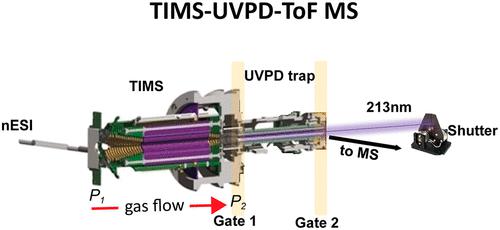当前位置:
X-MOL 学术
›
ACS Environ. Au
›
论文详情
Our official English website, www.x-mol.net, welcomes your feedback! (Note: you will need to create a separate account there.)
Trapped Ion Mobility Spectrometry, Ultraviolet Photodissociation, and Time-of-Flight Mass Spectrometry for Gas-Phase Peptide Isobars/Isomers/Conformers Discrimination
ACS Environmental Au Pub Date : 2022-06-05 , DOI: 10.1021/jasms.2c00091 Samuel A. Miller 1 , Kevin Jeanne Dit Fouque 1, 2 , Mark E. Ridgeway 3 , Melvin A. Park 3 , Francisco Fernandez-Lima 1, 2
ACS Environmental Au Pub Date : 2022-06-05 , DOI: 10.1021/jasms.2c00091 Samuel A. Miller 1 , Kevin Jeanne Dit Fouque 1, 2 , Mark E. Ridgeway 3 , Melvin A. Park 3 , Francisco Fernandez-Lima 1, 2
Affiliation

|
Trapped ion mobility spectrometry (TIMS) when coupled with mass spectrometry (MS) offers great advantages for the separation of isobaric, isomeric, and/or conformeric species. In the present work, we report the advantages of coupling TIMS with a low-cost, ultraviolet photodissociation (UVPD) linear ion trap operated at few mbars prior to time-of-flight (ToF) MS analysis for the effective characterization of isobaric, isomeric, and/or conformeric species based on mobility-selected fragmentation patterns. These three traditional challenges to MS-based separations are illustrated for the case of biologically relevant model systems: H3.1 histone tail PTM isobars (K4Me3/K18Ac), lanthipeptide regioisomers (overlapping/nonoverlapping ring patterns), and a model peptide conformer (angiotensin I). The sequential nature of the TIMS operation allows for effective synchronization with the ToF MS scans, in addition to parallel operation between the TIMS and the UVPD trap. Inspection of the mobility-selected UVPD MS spectra showed that for all three cases considered, unique fragmentation patterns (fingerprints) were observed per mobility band. Different from other IMS-UVPD implementations, the higher resolution of the TIMS device allowed for high mobility resolving power (R > 100) and effective mobility separation. The mobility selected UVPD MS provided high sequence coverage (>85%) with a fragmentation efficiency up to ∼40%.
中文翻译:

捕获离子淌度光谱法、紫外光解法和飞行时间质谱法用于气相肽等压线/异构体/构象体的鉴别
俘获离子淌度光谱法 (TIMS) 与质谱法 (MS) 结合使用时,可为同分异构体、异构体和/或构象异构体的分离提供巨大优势。在目前的工作中,我们报告了在飞行时间 (ToF) MS 分析之前将 TIMS 与低成本、紫外光解 (UVPD) 线性离子阱耦合的优势,以有效表征等压异构体。 ,和/或基于流动性选择的碎片模式的构象异构体。以生物相关模型系统为例,说明了基于 MS 的分离面临的这三个传统挑战:H3.1 组蛋白尾 PTM 等压线 (K4Me3/K18Ac)、羊毛肽区域异构体(重叠/非重叠环模式)和模型肽构象异构体(血管紧张素我)。除了 TIMS 和 UVPD 陷阱之间的并行操作之外,TIMS 操作的顺序性质允许与 ToF MS 扫描有效同步。检查迁移率选择的 UVPD MS 光谱表明,对于所考虑的所有三种情况,每个迁移率带都观察到独特的碎片模式(指纹)。与其他 IMS-UVPD 实施不同,TIMS 设备的高分辨率允许高迁移率分辨能力(R > 100) 和有效的流动性分离。流动性选择的 UVPD MS 提供了高序列覆盖率 (>85%),碎片效率高达 ∼40%。
更新日期:2022-06-05
中文翻译:

捕获离子淌度光谱法、紫外光解法和飞行时间质谱法用于气相肽等压线/异构体/构象体的鉴别
俘获离子淌度光谱法 (TIMS) 与质谱法 (MS) 结合使用时,可为同分异构体、异构体和/或构象异构体的分离提供巨大优势。在目前的工作中,我们报告了在飞行时间 (ToF) MS 分析之前将 TIMS 与低成本、紫外光解 (UVPD) 线性离子阱耦合的优势,以有效表征等压异构体。 ,和/或基于流动性选择的碎片模式的构象异构体。以生物相关模型系统为例,说明了基于 MS 的分离面临的这三个传统挑战:H3.1 组蛋白尾 PTM 等压线 (K4Me3/K18Ac)、羊毛肽区域异构体(重叠/非重叠环模式)和模型肽构象异构体(血管紧张素我)。除了 TIMS 和 UVPD 陷阱之间的并行操作之外,TIMS 操作的顺序性质允许与 ToF MS 扫描有效同步。检查迁移率选择的 UVPD MS 光谱表明,对于所考虑的所有三种情况,每个迁移率带都观察到独特的碎片模式(指纹)。与其他 IMS-UVPD 实施不同,TIMS 设备的高分辨率允许高迁移率分辨能力(R > 100) 和有效的流动性分离。流动性选择的 UVPD MS 提供了高序列覆盖率 (>85%),碎片效率高达 ∼40%。



























 京公网安备 11010802027423号
京公网安备 11010802027423号